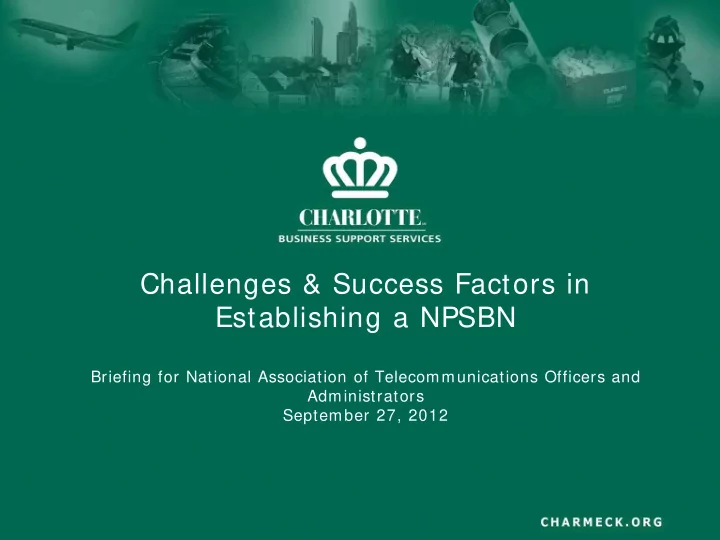

Challenges & Success Factors in Establishing a NPSBN Briefing for National Association of Telecommunications Officers and Administrators September 27, 2012
FirstNet-NC A Component of the NPSBN • Charlotte’s Support of FirstNet – Early advocate for national governance – Network Design o Mirrors FirstNet’s Basic Strategies – Push for Open Standards o Infrastructure interoperability Co-Chair of the PSST-OAC Infrastructure Internetworking Group Leading procurement effort for IPX services o Devices Leading procurement effort for Band 14 devices Focus on devices that support FirstNet strategy » Supporting of multiple APNs » UICC standards – Participating on FCC Interoperability Board
Where We Are • CharMeck Connect $21.1 Million Program – $16.7 M – Federal funds – $4.4 M - Recipient Match requirement (20% ) • $3.4 million provided by Vendor (Alcatel-Lucent) • $1 million provide by City through In-Kind Match • Considered Critical Component National PS Network
Where We Are • Completed Vendor Contracting – Alcatel-Lucent is LTE infrastructure and services provider – Crown-Castle USA is provider of commercial towers (28 to 30) – RCC Consultants is City’s Technical Consultant – Tech USA providing Program Management services (Steve Koman) • Network Deployment – Network design complete – Phase I fully staged & tested, ready to deploy – Local S&P Gateway and Hosted Core operational • Device Procurement In Pre-Order, Pilot Stage – Seven vendors participated; 4 RFPs received; likely 2 will enter Pilot – Device marketplace very slow to evolve • UICC vendor identify and ready to produce cards • NTIA Suspended funding May 11, 2012
Where We’re Going Urban Coverage Vehicle Modem Urban Handheld Urban Dense
Where We’re Going Mobile Coverage Portable Coverage BTOP Performance Period Aug 2010 – July 2013 CM CM-19 19 ~97% >90% "Mobile Coverage" is defined as the “Portable Coverage“ is defined as the minimum signal required to support the minimum signal required to support the minimum specified throughput performance minimum specified throughput performance while using the Vehicular Modem (with while using a PDA, worn on the hip with external antenna) installed in a typical police integral antenna. vehicle.
Where We’re Going Alcatel-Lucent Core RF BTOP Performance Period Aug 2010 – July 2013 VitalQIP IMS DNS 5420ISC SMS EMS LTE Core LTE Hosted Network NTP IeCCF Architecture FortiGate 310B Security GW SP IP Network City Of Charlotte Geographic Boundary 7750 S-PGWs LMR P25 Int ernet FortiGate SEG City Of Charlotte Backhaul City of Charlotte application Transport Network eNB eNB 7705 SAR-8 7705 SAR-8
National Public Safety Broadband Network Success begins with the answer to one question: Who are we building the network to serve on a daily basis? Local Public Safety and Emergency Responders
NPSBN Deployment • Challenges – Effectively managing procurement process o Planning that incorporates national and local priorities o Specifications with appropriate QoS (Public Safety Grade) o Appropriate deployment priorities o Development of effective/ efficient RFP processes – Maximizing the use of existing local assets o Local backhaul (fiber, microwave, etc) o Structures (Buildings, towers, land, etc.) o Local knowledge (serve demand, geography based capacity demands, etc.) Effective & Efficient project management/ controls – o Project scope is huge and complex o Network design in response to RFP will change many times o Many, many, many cooks in the kitchen
NPSBN Deployment • Success Factors – States do not “Opt Out” o Demonstrates effective collaboration with States and localities o Demonstrates procurement process buy in o Eases deployment schedule o Achieves economies of scale – Cost containment o Demonstrates effective & efficient project management/ controls o Demonstrates effective use of existing assets o Demonstrates effective collaboration with States and localities – Services that deliver o Achieves coverage & capacity needs of States and localities o Achieves a public safety grade QOS o Applications available when there need and where there needed
NPSBN Operations • Challenges – Developing a Shared Services Model o Establishing a Governance and Operating Model o Building the service infrastructure o Leveraging Partnerships o Building Customer Trust and Loyalty – Developing a predictable, competitive cost model o If not competitive, jurisdictions will opt for low cost option o If not predictable, will create customer relationship issues Rate should include infrastructure refresh costs If possible, a lease rate for devices that includes device refresh – Priority and Device management processes responsive to local situations o Situational prioritization must be immediately available to local jurisdictions
NPSBN Operations • Success Factors – Delivery!!!!! o 99.999s all the time o Capacity and Coverage where and when promised o Better than common carrier customer service o Performance reporting that proves it – Transparency o Everyone knows why it costs what it costs o Everyone knows what happened and why it happened o Everyone knows who is accountable – Public Safety moves critical voice to NPSBN o Demonstrates trust in system to deliver o Demonstrates confidence in the system operator o Demonstrates acceptance of the technology Direct connect and talk around are essential for acceptance
Role of NATOA Members • Leadership will vary from state to state • Think about how infrastructure asset can be leveraged • Look for ways to Facilitate, Coordinate and Collaborate • My Advice – Learn the Legislation (Title VI, Middle Class Tax Relief Act of 2012) – Develop strong relationships • State CIOs • Public safety organizations and their governance bodies • Infrastructure partners (e.g. state DOT, utilities (public & private), nonprofits, etc.) • Federal partners (DHS-OEC, NTIA and DOJ) – Study the planning guidelines – Learn the customer
Questions & Discussions
Recommend
More recommend